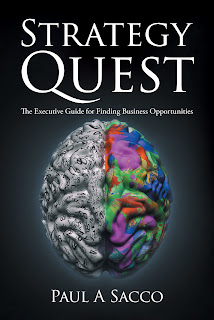This post is part of a virtual book tour organized by Goddess Fish Promotions. Paul Sacco will be awarding a $10 Amazon or B/N GC to a randomly drawn winner via rafflecopter during the tour. In addition, the publisher is offering this and several other books FREE for a limited time: https://books.bookfunnel.com/businesspromo/q6gn21s5w5. Click on the tour banner to see the other stops on the tour.
In Strategy Quest: The Executive Guide for Finding Business Opportunities, you will learn how to achieve the strategic mindset necessary to create and decide on the business opportunities that will put you ahead of your competition.
Using the psychology of personality type, you will understand how to make the shift to this growth mindset. In Strategy Quest, you will learn that the strategic mindset is composed of Strategic Intuition and Strategic Thinking. Strategic Intuition creates strategic visions and concepts, while strategic thinking decides if these are genuinely strategic and the right choice for your business.
Strategy Quest uses business examples to show what the strategic mindset is and isn’t. The book also equips you with the tools that you will need for your Strategy Quest and shows you how to overcome the obstacle that you might encounter.
Read an Exclusive Excerpt
The strategic mindset follows a similar process as creative problem-solving. The difference is that with creative problem-solving, we are usually reacting to a nebulous yet tangible problem, while the strategic mindset undertakes a quest to find opportunities to fulfill an abstract goal that might not be associated with a tangible issue.
The first book on creative problem-solving, The Art of Thought (7), was written by Graham Wallas, cofounder of the London School of Economics. In his book, Wallas described a four-step method. In the first step, preparation, the problem is “investigated in all directions.” Wallas referred to the second stage as Incubation. During this step, Wallas advised avoiding conscious thought of the problem to permit the “combinatory play” of the mind to go to work on the problem. The third step is Illumination, in which a “happy idea” comes into consciousness. The happy idea is synonymous with a vision. The fourth stage involved verification of the idea.
The Strategy Quest Method expands Wallas’ four-step method into the six sub-quests illustrated in Figure 10 - The Strategy Quest Method. To complete this adaption, I undertook my Strategy Quest by researching military and business strategy, psychology, neuroscience, and creativity. My own experience as an INTJ contributed a great deal to envisioning this method, conceptualizing it, and ensuring that it made sense.
The Strategy Quest Method begins by aligning your intrinsic motivation with strategic feelings (FiS). You will then proceed on a quest to find a strategic goal. Next, using Strategic Intuition (NiS), you will create a vision for achieving your goal. After you transform your vision into a tangible concept, you will use Strategic Thinking (TeS) to determine if your concept is a real strategic opportunity and to decide if it an appropriate opportunity for your business.
Unless primarily driven by intrinsic motivation, you won’t be able to complete your Strategy Quest. Intrinsic motivation is what drives us to do the things that we enjoy. Doing things that we enjoy results in the brain’s release of the feel-good neurochemical, dopamine. In contrast, extrinsic motivations compel us to do things for others. Extrinsic motivation induces us with either rewards (i.e., carrot) or punishment (i.e., the stick). Extrinsic rewards include compensation, promotion, recognition, status, and power. Extrinsic punishment can come by way of withholding rewards, termination, negative feedback, or other means.
In his book, Drive (8), author Daniel Pink asserts that extrinsic rewards alone do not motivate us to accomplish long-term goals. Since finding and implementing a strategic opportunity takes place in the long term, intrinsic motivation is necessary. Pink also makes the point that we need intrinsic motivation to accomplish complex tasks. As an executive, your Strategy Quest is the most complex challenge that you are likely to encounter in your professional career.
About the Author:As President of Propheta Lucro Management Consultants, Paul specializes in helping leaders find strategic opportunities. One of the world's top experts in strategic thinking, Paul has over 35 years of experience managing and leading businesses. He is a graduate of the University of Toronto holding both a B.A. Sc. in Chemical Engineering and an MBA from the Rotman School of Management. Paul is available to speak about business strategy or to teach, coach or facilitate the Strategy Quest method. For more information visit our web-site at: www.prophetalucro.com Or contact Paul at: Email: Paul@prophetalucro.com
CONNECT WITH Paul
WEBSITE:
FACEBOOK https://www.facebook.com/PLIdeas/
LINKEDIN https://www.linkedin.com/in/paulsacco/
GOODREADS https://www.goodreads.com/author/show/20438419.Paul_A_Sacco
AMAZON.CA https://amazon.ca/dp/022880843X
BOOKSHOP https://bookshop.org/books/strategy-quest-the-executive-guide-to-finding-business-opportunities-9780228808466/9780228808435
INDIGO CHAPTERS https://www.chapters.indigo.ca/en-ca/books/strategy-quest-the-executive-guide/9780228808459-item.html
BARNES & NOBLE https://www.barnesandnoble.com/w/strategy-quest-paul-a-sacco/1137187052
BOOK DEPOSITORY https://www.bookdepository.com/Strategy-Quest-Paul-Sacco/9780228808435
SMASHWORDS https://www.smashwords.com/books/view/1028030
APPLE BOOKS https://books.apple.com/us/book/strategy-quest-executive-guide-to-finding-business/id1518883691
a Rafflecopter giveaway




Thanks for hosting!
ReplyDeleteSounds like a good book.
ReplyDeleteCould be very useful.
ReplyDeleteThank you for hosting my book, Strategy Quest.
ReplyDeleteRegards,
Paul Sacco
Interesting ideas! Thanks for the giveaway.
ReplyDeleteThe book sounds fascinating! Thanks!
ReplyDelete